Understanding Challenging Behaviour of Disabled Patients
VerifiedAdded on 2020/10/22
|10
|2241
|71
AI Summary
The report discusses the impact of challenging behaviour on staff, health, and safety within a hospital. It highlights the importance of understanding specific patient needs to provide effective treatment. Strategies such as coordination between departments, medical and behavioural counselling, and interacting with patients in a normal manner are proposed to improve patient conditions and lead better lives.
Contribute Materials
Your contribution can guide someone’s learning journey. Share your
documents today.
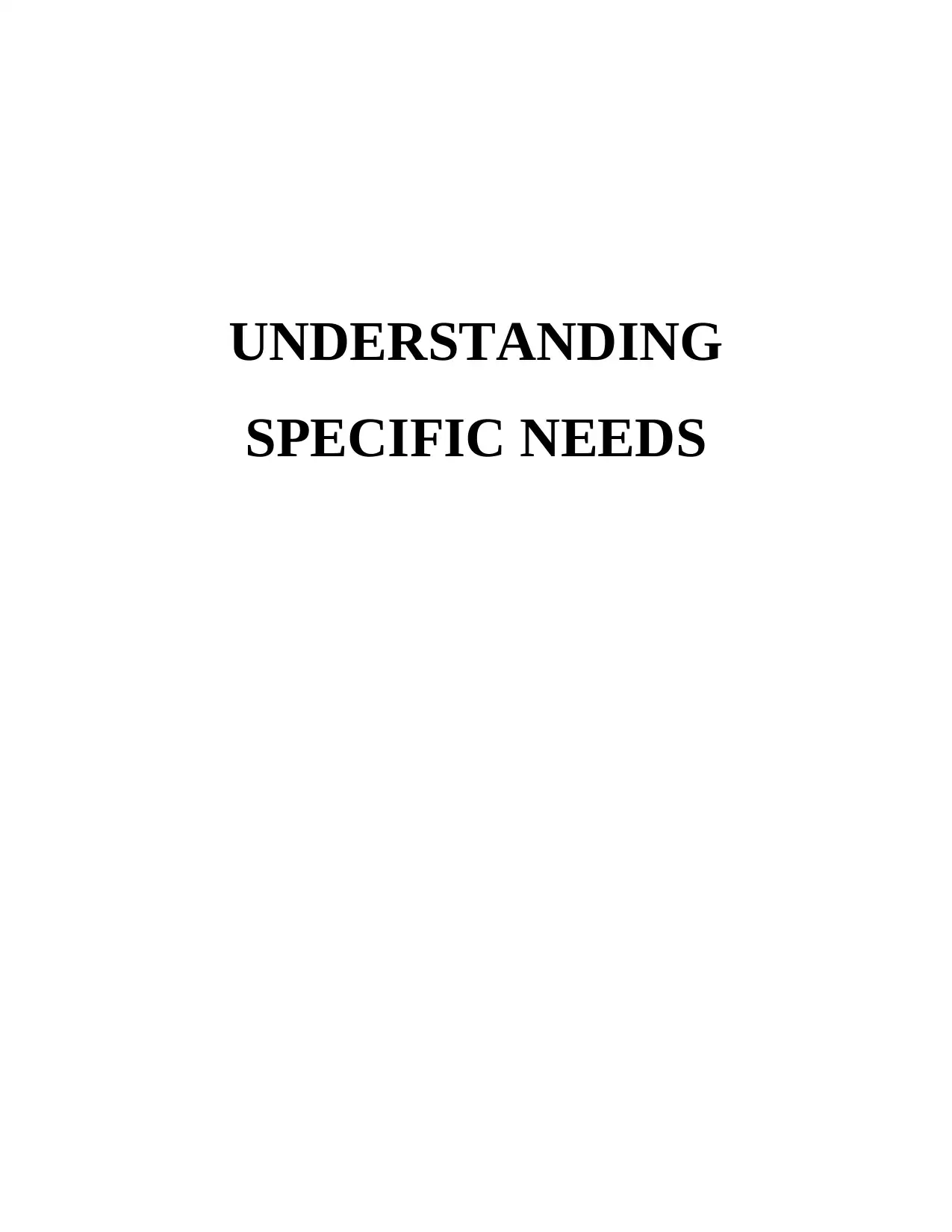
UNDERSTANDING
SPECIFIC NEEDS
SPECIFIC NEEDS
Secure Best Marks with AI Grader
Need help grading? Try our AI Grader for instant feedback on your assignments.
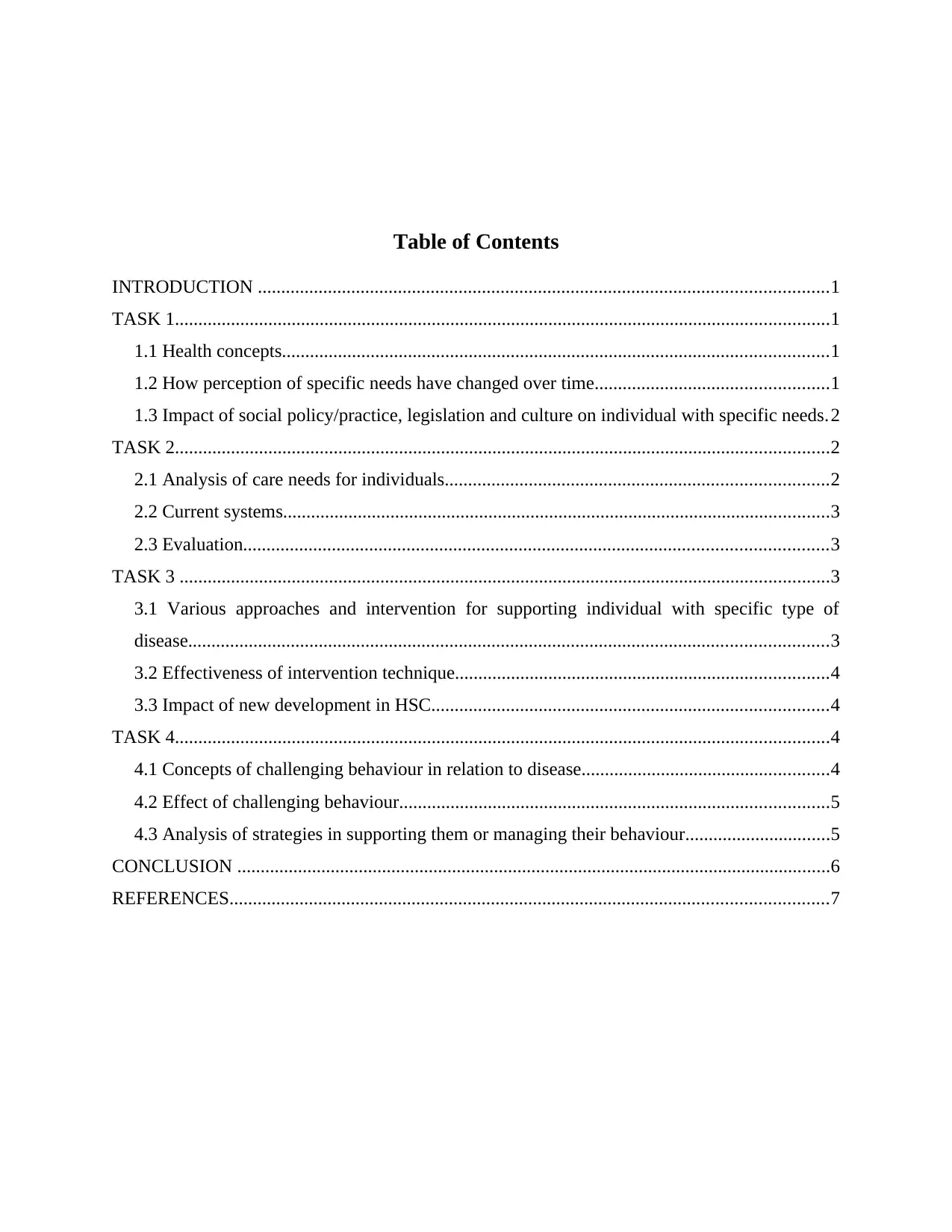
Table of Contents
INTRODUCTION ..........................................................................................................................1
TASK 1............................................................................................................................................1
1.1 Health concepts.....................................................................................................................1
1.2 How perception of specific needs have changed over time..................................................1
1.3 Impact of social policy/practice, legislation and culture on individual with specific needs.2
TASK 2............................................................................................................................................2
2.1 Analysis of care needs for individuals..................................................................................2
2.2 Current systems.....................................................................................................................3
2.3 Evaluation.............................................................................................................................3
TASK 3 ...........................................................................................................................................3
3.1 Various approaches and intervention for supporting individual with specific type of
disease.........................................................................................................................................3
3.2 Effectiveness of intervention technique................................................................................4
3.3 Impact of new development in HSC.....................................................................................4
TASK 4............................................................................................................................................4
4.1 Concepts of challenging behaviour in relation to disease.....................................................4
4.2 Effect of challenging behaviour............................................................................................5
4.3 Analysis of strategies in supporting them or managing their behaviour...............................5
CONCLUSION ...............................................................................................................................6
REFERENCES................................................................................................................................7
INTRODUCTION ..........................................................................................................................1
TASK 1............................................................................................................................................1
1.1 Health concepts.....................................................................................................................1
1.2 How perception of specific needs have changed over time..................................................1
1.3 Impact of social policy/practice, legislation and culture on individual with specific needs.2
TASK 2............................................................................................................................................2
2.1 Analysis of care needs for individuals..................................................................................2
2.2 Current systems.....................................................................................................................3
2.3 Evaluation.............................................................................................................................3
TASK 3 ...........................................................................................................................................3
3.1 Various approaches and intervention for supporting individual with specific type of
disease.........................................................................................................................................3
3.2 Effectiveness of intervention technique................................................................................4
3.3 Impact of new development in HSC.....................................................................................4
TASK 4............................................................................................................................................4
4.1 Concepts of challenging behaviour in relation to disease.....................................................4
4.2 Effect of challenging behaviour............................................................................................5
4.3 Analysis of strategies in supporting them or managing their behaviour...............................5
CONCLUSION ...............................................................................................................................6
REFERENCES................................................................................................................................7
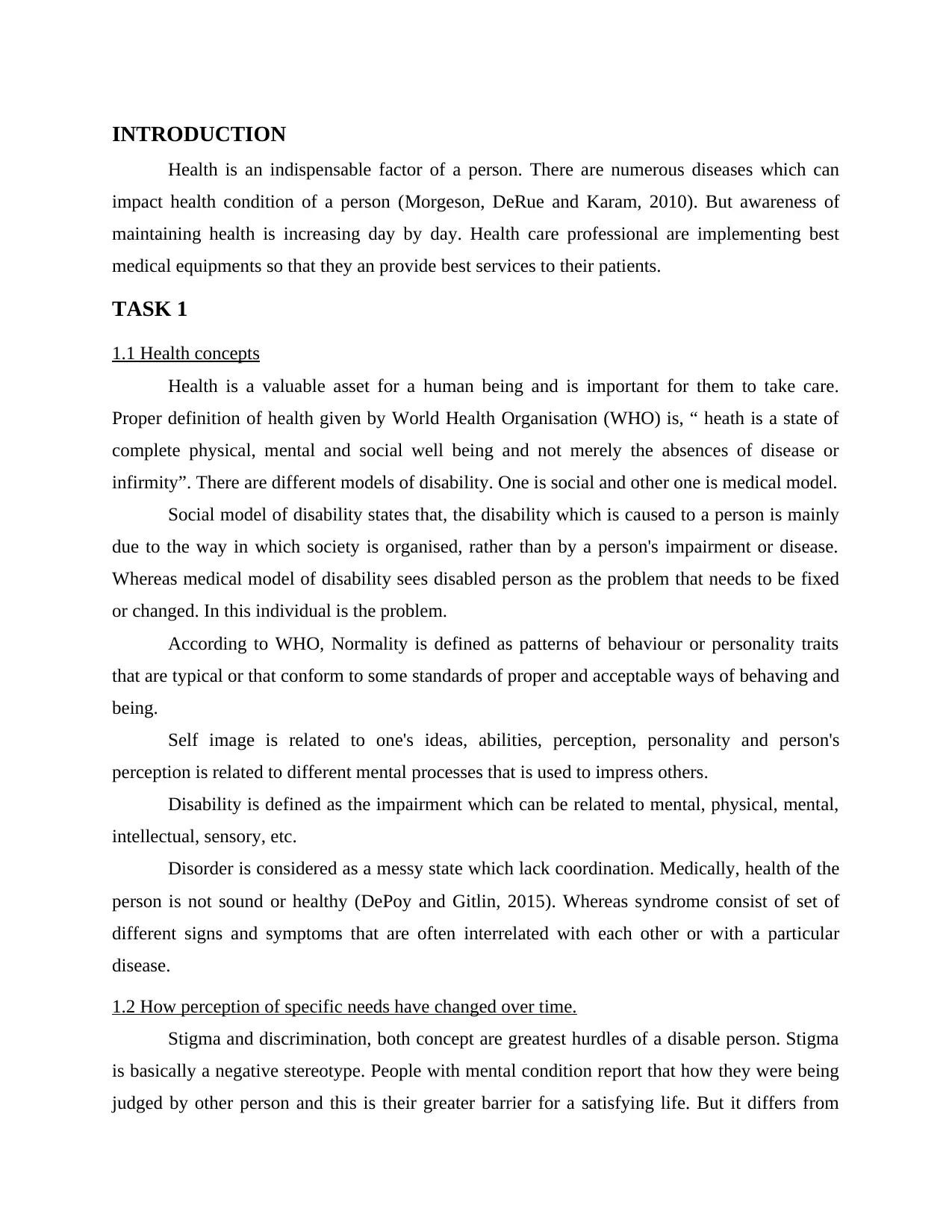
INTRODUCTION
Health is an indispensable factor of a person. There are numerous diseases which can
impact health condition of a person (Morgeson, DeRue and Karam, 2010). But awareness of
maintaining health is increasing day by day. Health care professional are implementing best
medical equipments so that they an provide best services to their patients.
TASK 1
1.1 Health concepts
Health is a valuable asset for a human being and is important for them to take care.
Proper definition of health given by World Health Organisation (WHO) is, “ heath is a state of
complete physical, mental and social well being and not merely the absences of disease or
infirmity”. There are different models of disability. One is social and other one is medical model.
Social model of disability states that, the disability which is caused to a person is mainly
due to the way in which society is organised, rather than by a person's impairment or disease.
Whereas medical model of disability sees disabled person as the problem that needs to be fixed
or changed. In this individual is the problem.
According to WHO, Normality is defined as patterns of behaviour or personality traits
that are typical or that conform to some standards of proper and acceptable ways of behaving and
being.
Self image is related to one's ideas, abilities, perception, personality and person's
perception is related to different mental processes that is used to impress others.
Disability is defined as the impairment which can be related to mental, physical, mental,
intellectual, sensory, etc.
Disorder is considered as a messy state which lack coordination. Medically, health of the
person is not sound or healthy (DePoy and Gitlin, 2015). Whereas syndrome consist of set of
different signs and symptoms that are often interrelated with each other or with a particular
disease.
1.2 How perception of specific needs have changed over time.
Stigma and discrimination, both concept are greatest hurdles of a disable person. Stigma
is basically a negative stereotype. People with mental condition report that how they were being
judged by other person and this is their greater barrier for a satisfying life. But it differs from
Health is an indispensable factor of a person. There are numerous diseases which can
impact health condition of a person (Morgeson, DeRue and Karam, 2010). But awareness of
maintaining health is increasing day by day. Health care professional are implementing best
medical equipments so that they an provide best services to their patients.
TASK 1
1.1 Health concepts
Health is a valuable asset for a human being and is important for them to take care.
Proper definition of health given by World Health Organisation (WHO) is, “ heath is a state of
complete physical, mental and social well being and not merely the absences of disease or
infirmity”. There are different models of disability. One is social and other one is medical model.
Social model of disability states that, the disability which is caused to a person is mainly
due to the way in which society is organised, rather than by a person's impairment or disease.
Whereas medical model of disability sees disabled person as the problem that needs to be fixed
or changed. In this individual is the problem.
According to WHO, Normality is defined as patterns of behaviour or personality traits
that are typical or that conform to some standards of proper and acceptable ways of behaving and
being.
Self image is related to one's ideas, abilities, perception, personality and person's
perception is related to different mental processes that is used to impress others.
Disability is defined as the impairment which can be related to mental, physical, mental,
intellectual, sensory, etc.
Disorder is considered as a messy state which lack coordination. Medically, health of the
person is not sound or healthy (DePoy and Gitlin, 2015). Whereas syndrome consist of set of
different signs and symptoms that are often interrelated with each other or with a particular
disease.
1.2 How perception of specific needs have changed over time.
Stigma and discrimination, both concept are greatest hurdles of a disable person. Stigma
is basically a negative stereotype. People with mental condition report that how they were being
judged by other person and this is their greater barrier for a satisfying life. But it differs from
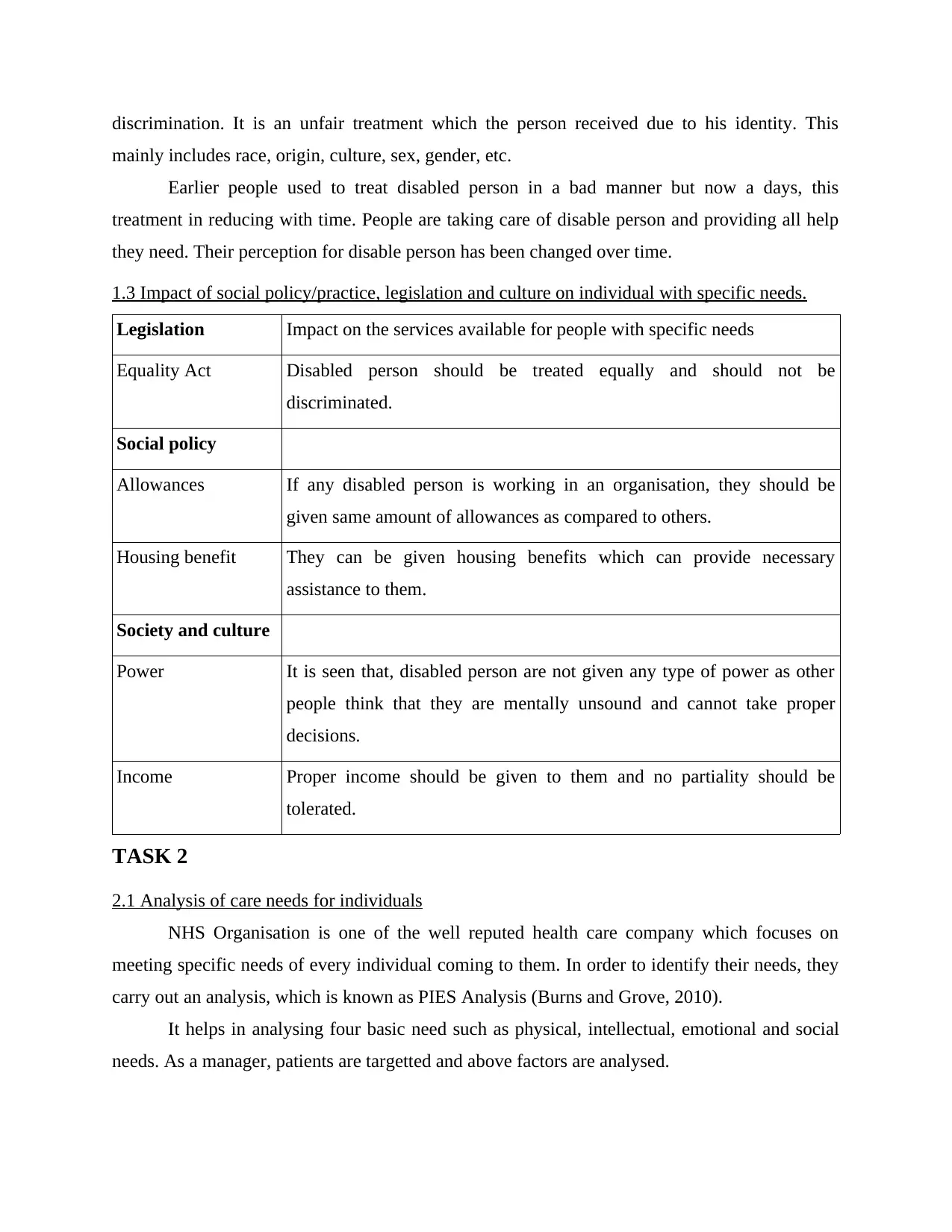
discrimination. It is an unfair treatment which the person received due to his identity. This
mainly includes race, origin, culture, sex, gender, etc.
Earlier people used to treat disabled person in a bad manner but now a days, this
treatment in reducing with time. People are taking care of disable person and providing all help
they need. Their perception for disable person has been changed over time.
1.3 Impact of social policy/practice, legislation and culture on individual with specific needs.
Legislation Impact on the services available for people with specific needs
Equality Act Disabled person should be treated equally and should not be
discriminated.
Social policy
Allowances If any disabled person is working in an organisation, they should be
given same amount of allowances as compared to others.
Housing benefit They can be given housing benefits which can provide necessary
assistance to them.
Society and culture
Power It is seen that, disabled person are not given any type of power as other
people think that they are mentally unsound and cannot take proper
decisions.
Income Proper income should be given to them and no partiality should be
tolerated.
TASK 2
2.1 Analysis of care needs for individuals
NHS Organisation is one of the well reputed health care company which focuses on
meeting specific needs of every individual coming to them. In order to identify their needs, they
carry out an analysis, which is known as PIES Analysis (Burns and Grove, 2010).
It helps in analysing four basic need such as physical, intellectual, emotional and social
needs. As a manager, patients are targetted and above factors are analysed.
mainly includes race, origin, culture, sex, gender, etc.
Earlier people used to treat disabled person in a bad manner but now a days, this
treatment in reducing with time. People are taking care of disable person and providing all help
they need. Their perception for disable person has been changed over time.
1.3 Impact of social policy/practice, legislation and culture on individual with specific needs.
Legislation Impact on the services available for people with specific needs
Equality Act Disabled person should be treated equally and should not be
discriminated.
Social policy
Allowances If any disabled person is working in an organisation, they should be
given same amount of allowances as compared to others.
Housing benefit They can be given housing benefits which can provide necessary
assistance to them.
Society and culture
Power It is seen that, disabled person are not given any type of power as other
people think that they are mentally unsound and cannot take proper
decisions.
Income Proper income should be given to them and no partiality should be
tolerated.
TASK 2
2.1 Analysis of care needs for individuals
NHS Organisation is one of the well reputed health care company which focuses on
meeting specific needs of every individual coming to them. In order to identify their needs, they
carry out an analysis, which is known as PIES Analysis (Burns and Grove, 2010).
It helps in analysing four basic need such as physical, intellectual, emotional and social
needs. As a manager, patients are targetted and above factors are analysed.
Secure Best Marks with AI Grader
Need help grading? Try our AI Grader for instant feedback on your assignments.
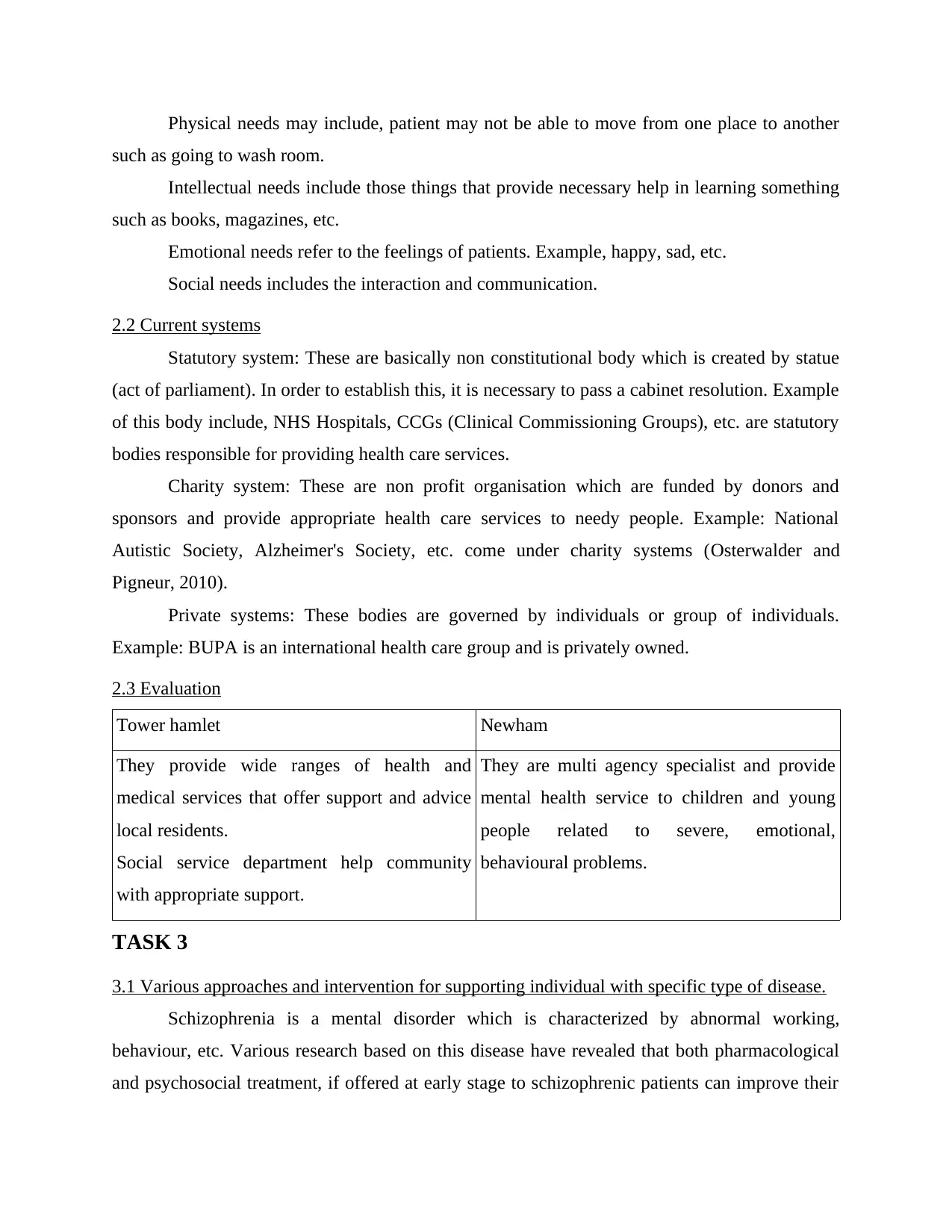
Physical needs may include, patient may not be able to move from one place to another
such as going to wash room.
Intellectual needs include those things that provide necessary help in learning something
such as books, magazines, etc.
Emotional needs refer to the feelings of patients. Example, happy, sad, etc.
Social needs includes the interaction and communication.
2.2 Current systems
Statutory system: These are basically non constitutional body which is created by statue
(act of parliament). In order to establish this, it is necessary to pass a cabinet resolution. Example
of this body include, NHS Hospitals, CCGs (Clinical Commissioning Groups), etc. are statutory
bodies responsible for providing health care services.
Charity system: These are non profit organisation which are funded by donors and
sponsors and provide appropriate health care services to needy people. Example: National
Autistic Society, Alzheimer's Society, etc. come under charity systems (Osterwalder and
Pigneur, 2010).
Private systems: These bodies are governed by individuals or group of individuals.
Example: BUPA is an international health care group and is privately owned.
2.3 Evaluation
Tower hamlet Newham
They provide wide ranges of health and
medical services that offer support and advice
local residents.
Social service department help community
with appropriate support.
They are multi agency specialist and provide
mental health service to children and young
people related to severe, emotional,
behavioural problems.
TASK 3
3.1 Various approaches and intervention for supporting individual with specific type of disease.
Schizophrenia is a mental disorder which is characterized by abnormal working,
behaviour, etc. Various research based on this disease have revealed that both pharmacological
and psychosocial treatment, if offered at early stage to schizophrenic patients can improve their
such as going to wash room.
Intellectual needs include those things that provide necessary help in learning something
such as books, magazines, etc.
Emotional needs refer to the feelings of patients. Example, happy, sad, etc.
Social needs includes the interaction and communication.
2.2 Current systems
Statutory system: These are basically non constitutional body which is created by statue
(act of parliament). In order to establish this, it is necessary to pass a cabinet resolution. Example
of this body include, NHS Hospitals, CCGs (Clinical Commissioning Groups), etc. are statutory
bodies responsible for providing health care services.
Charity system: These are non profit organisation which are funded by donors and
sponsors and provide appropriate health care services to needy people. Example: National
Autistic Society, Alzheimer's Society, etc. come under charity systems (Osterwalder and
Pigneur, 2010).
Private systems: These bodies are governed by individuals or group of individuals.
Example: BUPA is an international health care group and is privately owned.
2.3 Evaluation
Tower hamlet Newham
They provide wide ranges of health and
medical services that offer support and advice
local residents.
Social service department help community
with appropriate support.
They are multi agency specialist and provide
mental health service to children and young
people related to severe, emotional,
behavioural problems.
TASK 3
3.1 Various approaches and intervention for supporting individual with specific type of disease.
Schizophrenia is a mental disorder which is characterized by abnormal working,
behaviour, etc. Various research based on this disease have revealed that both pharmacological
and psychosocial treatment, if offered at early stage to schizophrenic patients can improve their
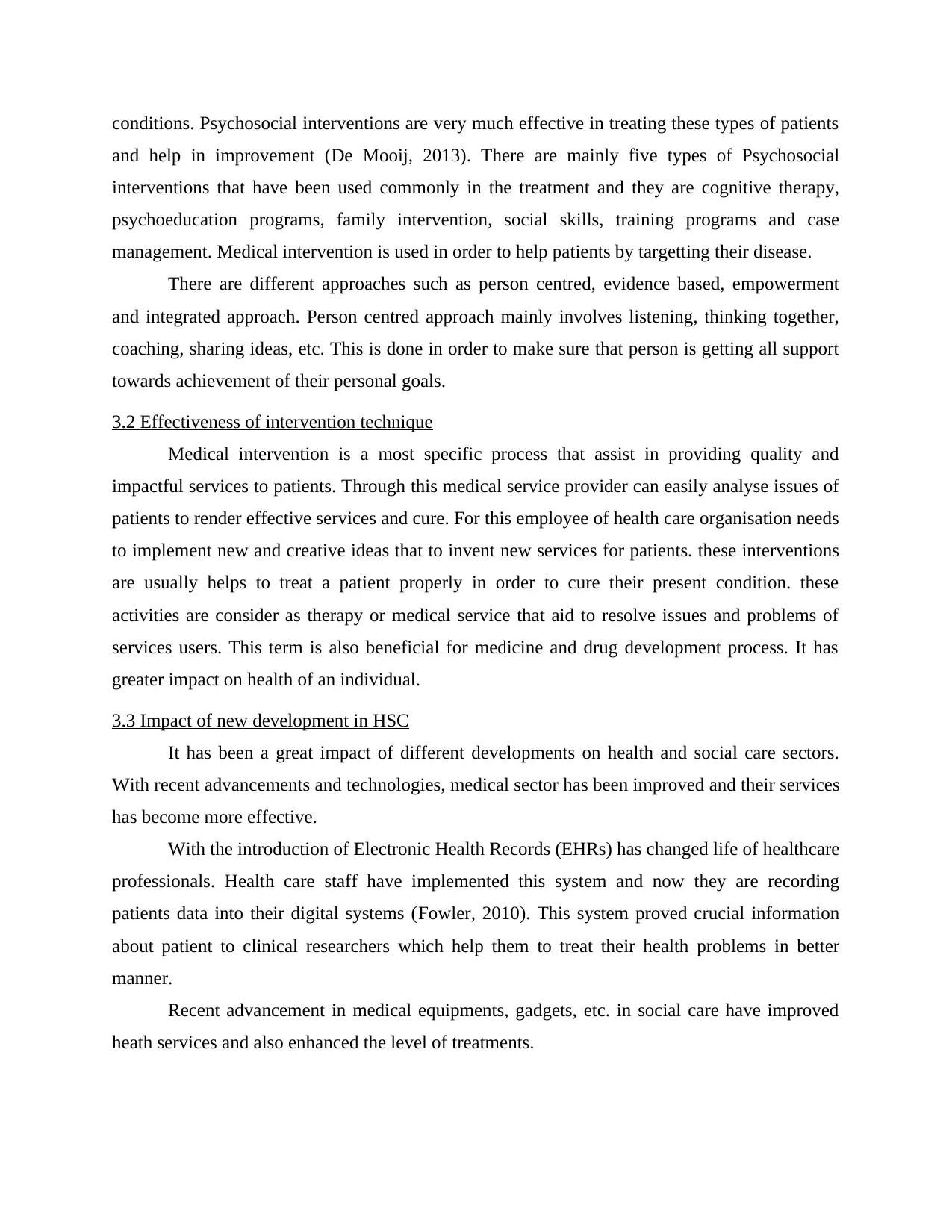
conditions. Psychosocial interventions are very much effective in treating these types of patients
and help in improvement (De Mooij, 2013). There are mainly five types of Psychosocial
interventions that have been used commonly in the treatment and they are cognitive therapy,
psychoeducation programs, family intervention, social skills, training programs and case
management. Medical intervention is used in order to help patients by targetting their disease.
There are different approaches such as person centred, evidence based, empowerment
and integrated approach. Person centred approach mainly involves listening, thinking together,
coaching, sharing ideas, etc. This is done in order to make sure that person is getting all support
towards achievement of their personal goals.
3.2 Effectiveness of intervention technique
Medical intervention is a most specific process that assist in providing quality and
impactful services to patients. Through this medical service provider can easily analyse issues of
patients to render effective services and cure. For this employee of health care organisation needs
to implement new and creative ideas that to invent new services for patients. these interventions
are usually helps to treat a patient properly in order to cure their present condition. these
activities are consider as therapy or medical service that aid to resolve issues and problems of
services users. This term is also beneficial for medicine and drug development process. It has
greater impact on health of an individual.
3.3 Impact of new development in HSC
It has been a great impact of different developments on health and social care sectors.
With recent advancements and technologies, medical sector has been improved and their services
has become more effective.
With the introduction of Electronic Health Records (EHRs) has changed life of healthcare
professionals. Health care staff have implemented this system and now they are recording
patients data into their digital systems (Fowler, 2010). This system proved crucial information
about patient to clinical researchers which help them to treat their health problems in better
manner.
Recent advancement in medical equipments, gadgets, etc. in social care have improved
heath services and also enhanced the level of treatments.
and help in improvement (De Mooij, 2013). There are mainly five types of Psychosocial
interventions that have been used commonly in the treatment and they are cognitive therapy,
psychoeducation programs, family intervention, social skills, training programs and case
management. Medical intervention is used in order to help patients by targetting their disease.
There are different approaches such as person centred, evidence based, empowerment
and integrated approach. Person centred approach mainly involves listening, thinking together,
coaching, sharing ideas, etc. This is done in order to make sure that person is getting all support
towards achievement of their personal goals.
3.2 Effectiveness of intervention technique
Medical intervention is a most specific process that assist in providing quality and
impactful services to patients. Through this medical service provider can easily analyse issues of
patients to render effective services and cure. For this employee of health care organisation needs
to implement new and creative ideas that to invent new services for patients. these interventions
are usually helps to treat a patient properly in order to cure their present condition. these
activities are consider as therapy or medical service that aid to resolve issues and problems of
services users. This term is also beneficial for medicine and drug development process. It has
greater impact on health of an individual.
3.3 Impact of new development in HSC
It has been a great impact of different developments on health and social care sectors.
With recent advancements and technologies, medical sector has been improved and their services
has become more effective.
With the introduction of Electronic Health Records (EHRs) has changed life of healthcare
professionals. Health care staff have implemented this system and now they are recording
patients data into their digital systems (Fowler, 2010). This system proved crucial information
about patient to clinical researchers which help them to treat their health problems in better
manner.
Recent advancement in medical equipments, gadgets, etc. in social care have improved
heath services and also enhanced the level of treatments.
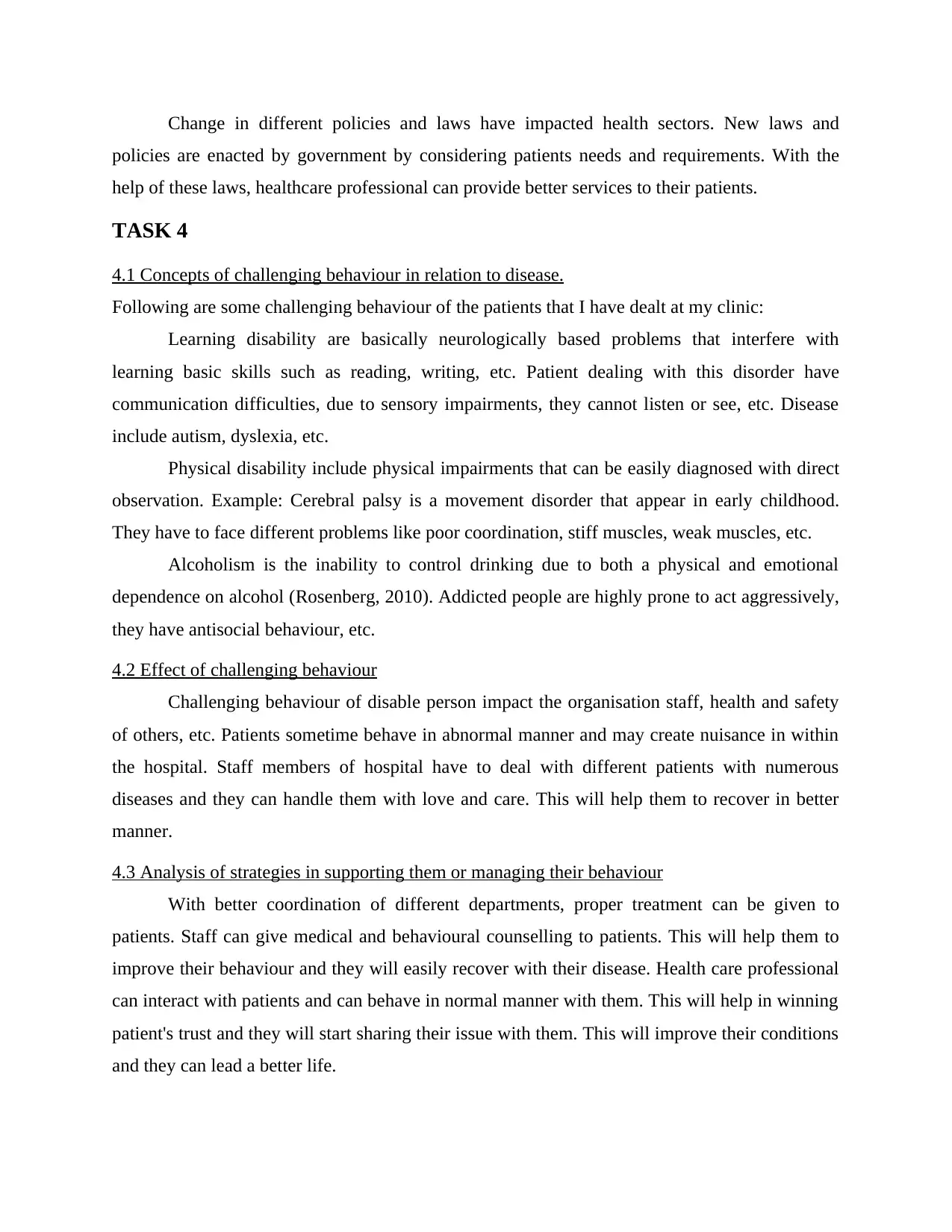
Change in different policies and laws have impacted health sectors. New laws and
policies are enacted by government by considering patients needs and requirements. With the
help of these laws, healthcare professional can provide better services to their patients.
TASK 4
4.1 Concepts of challenging behaviour in relation to disease.
Following are some challenging behaviour of the patients that I have dealt at my clinic:
Learning disability are basically neurologically based problems that interfere with
learning basic skills such as reading, writing, etc. Patient dealing with this disorder have
communication difficulties, due to sensory impairments, they cannot listen or see, etc. Disease
include autism, dyslexia, etc.
Physical disability include physical impairments that can be easily diagnosed with direct
observation. Example: Cerebral palsy is a movement disorder that appear in early childhood.
They have to face different problems like poor coordination, stiff muscles, weak muscles, etc.
Alcoholism is the inability to control drinking due to both a physical and emotional
dependence on alcohol (Rosenberg, 2010). Addicted people are highly prone to act aggressively,
they have antisocial behaviour, etc.
4.2 Effect of challenging behaviour
Challenging behaviour of disable person impact the organisation staff, health and safety
of others, etc. Patients sometime behave in abnormal manner and may create nuisance in within
the hospital. Staff members of hospital have to deal with different patients with numerous
diseases and they can handle them with love and care. This will help them to recover in better
manner.
4.3 Analysis of strategies in supporting them or managing their behaviour
With better coordination of different departments, proper treatment can be given to
patients. Staff can give medical and behavioural counselling to patients. This will help them to
improve their behaviour and they will easily recover with their disease. Health care professional
can interact with patients and can behave in normal manner with them. This will help in winning
patient's trust and they will start sharing their issue with them. This will improve their conditions
and they can lead a better life.
policies are enacted by government by considering patients needs and requirements. With the
help of these laws, healthcare professional can provide better services to their patients.
TASK 4
4.1 Concepts of challenging behaviour in relation to disease.
Following are some challenging behaviour of the patients that I have dealt at my clinic:
Learning disability are basically neurologically based problems that interfere with
learning basic skills such as reading, writing, etc. Patient dealing with this disorder have
communication difficulties, due to sensory impairments, they cannot listen or see, etc. Disease
include autism, dyslexia, etc.
Physical disability include physical impairments that can be easily diagnosed with direct
observation. Example: Cerebral palsy is a movement disorder that appear in early childhood.
They have to face different problems like poor coordination, stiff muscles, weak muscles, etc.
Alcoholism is the inability to control drinking due to both a physical and emotional
dependence on alcohol (Rosenberg, 2010). Addicted people are highly prone to act aggressively,
they have antisocial behaviour, etc.
4.2 Effect of challenging behaviour
Challenging behaviour of disable person impact the organisation staff, health and safety
of others, etc. Patients sometime behave in abnormal manner and may create nuisance in within
the hospital. Staff members of hospital have to deal with different patients with numerous
diseases and they can handle them with love and care. This will help them to recover in better
manner.
4.3 Analysis of strategies in supporting them or managing their behaviour
With better coordination of different departments, proper treatment can be given to
patients. Staff can give medical and behavioural counselling to patients. This will help them to
improve their behaviour and they will easily recover with their disease. Health care professional
can interact with patients and can behave in normal manner with them. This will help in winning
patient's trust and they will start sharing their issue with them. This will improve their conditions
and they can lead a better life.
Paraphrase This Document
Need a fresh take? Get an instant paraphrase of this document with our AI Paraphraser

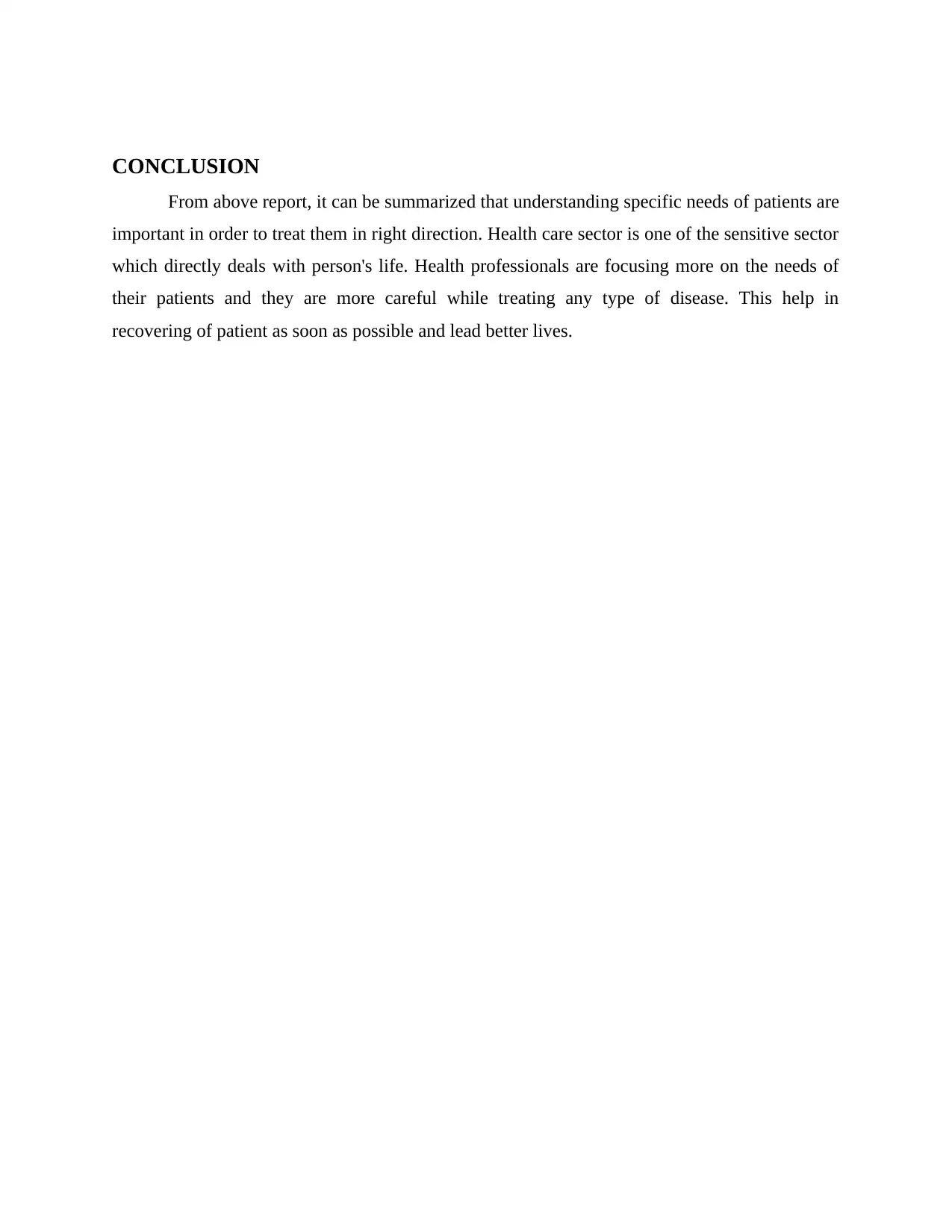
CONCLUSION
From above report, it can be summarized that understanding specific needs of patients are
important in order to treat them in right direction. Health care sector is one of the sensitive sector
which directly deals with person's life. Health professionals are focusing more on the needs of
their patients and they are more careful while treating any type of disease. This help in
recovering of patient as soon as possible and lead better lives.
From above report, it can be summarized that understanding specific needs of patients are
important in order to treat them in right direction. Health care sector is one of the sensitive sector
which directly deals with person's life. Health professionals are focusing more on the needs of
their patients and they are more careful while treating any type of disease. This help in
recovering of patient as soon as possible and lead better lives.
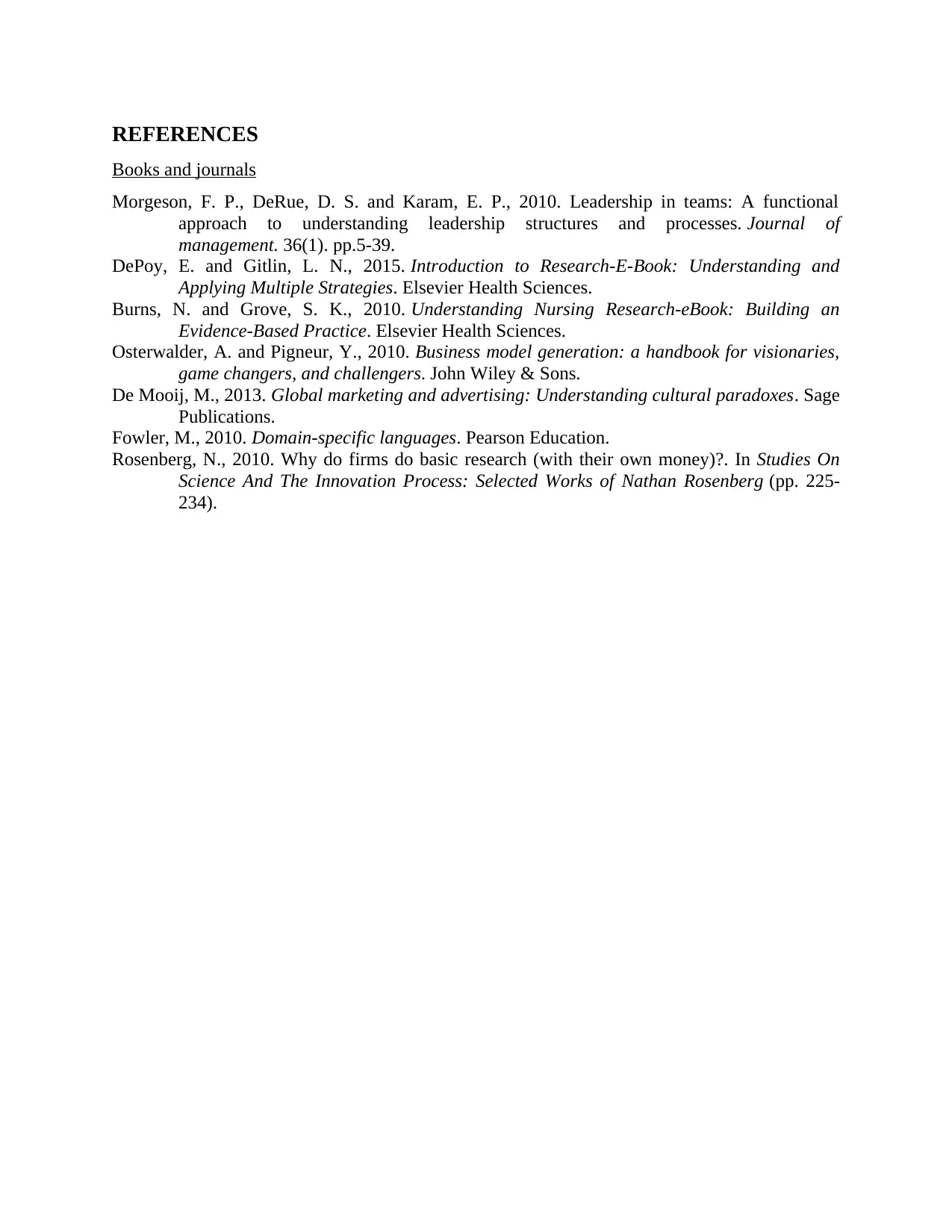
REFERENCES
Books and journals
Morgeson, F. P., DeRue, D. S. and Karam, E. P., 2010. Leadership in teams: A functional
approach to understanding leadership structures and processes. Journal of
management. 36(1). pp.5-39.
DePoy, E. and Gitlin, L. N., 2015. Introduction to Research-E-Book: Understanding and
Applying Multiple Strategies. Elsevier Health Sciences.
Burns, N. and Grove, S. K., 2010. Understanding Nursing Research-eBook: Building an
Evidence-Based Practice. Elsevier Health Sciences.
Osterwalder, A. and Pigneur, Y., 2010. Business model generation: a handbook for visionaries,
game changers, and challengers. John Wiley & Sons.
De Mooij, M., 2013. Global marketing and advertising: Understanding cultural paradoxes. Sage
Publications.
Fowler, M., 2010. Domain-specific languages. Pearson Education.
Rosenberg, N., 2010. Why do firms do basic research (with their own money)?. In Studies On
Science And The Innovation Process: Selected Works of Nathan Rosenberg (pp. 225-
234).
Books and journals
Morgeson, F. P., DeRue, D. S. and Karam, E. P., 2010. Leadership in teams: A functional
approach to understanding leadership structures and processes. Journal of
management. 36(1). pp.5-39.
DePoy, E. and Gitlin, L. N., 2015. Introduction to Research-E-Book: Understanding and
Applying Multiple Strategies. Elsevier Health Sciences.
Burns, N. and Grove, S. K., 2010. Understanding Nursing Research-eBook: Building an
Evidence-Based Practice. Elsevier Health Sciences.
Osterwalder, A. and Pigneur, Y., 2010. Business model generation: a handbook for visionaries,
game changers, and challengers. John Wiley & Sons.
De Mooij, M., 2013. Global marketing and advertising: Understanding cultural paradoxes. Sage
Publications.
Fowler, M., 2010. Domain-specific languages. Pearson Education.
Rosenberg, N., 2010. Why do firms do basic research (with their own money)?. In Studies On
Science And The Innovation Process: Selected Works of Nathan Rosenberg (pp. 225-
234).
1 out of 10
Related Documents
Your All-in-One AI-Powered Toolkit for Academic Success.
+13062052269
info@desklib.com
Available 24*7 on WhatsApp / Email
![[object Object]](/_next/static/media/star-bottom.7253800d.svg)
Unlock your academic potential
© 2024 | Zucol Services PVT LTD | All rights reserved.





